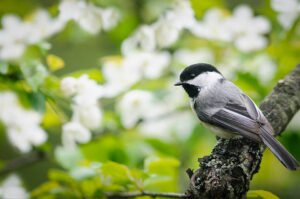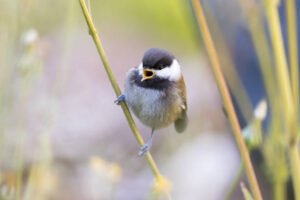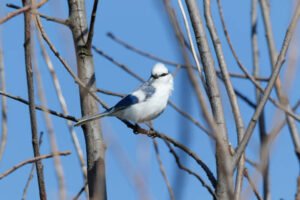
The enchanting chickadee, a small and charismatic bird known for its distinctive black-capped head and cheerful call, has captured the fascination of bird enthusiasts and casual observers alike. As these tiny creatures flit about in gardens, woodlands, and suburban landscapes, a common question arises: How long do chickadees live? This inquiry delves into the intricate world of avian biology, ecology, and the challenges these delightful birds face in their quest for survival.
The lifespan of chickadees is a subject that encompasses a spectrum of factors, ranging from species-specific traits to environmental influences. With several species falling under the chickadee umbrella, including the Black-capped Chickadee and the Carolina Chickadee, each boasts unique adaptations and behaviors contributing to its longevity. Exploring chickadees’ life cycle involves examining their nesting habits, diet, and interactions within their ecosystems.
Beyond the superficial charm of their appearance, chickadees play pivotal roles in maintaining ecological balance. Their foraging behaviors, social structures, and ability to adapt to diverse habitats make them integral components of the avian community. This exploration into the lifespan of chickadees offers a broader understanding of the interconnected web of life, emphasizing the significance of these seemingly modest birds in the grand tapestry of nature.
Embarking on this journey of discovery, we will unravel the mysteries surrounding the lifespan of chickadees, exploring the factors that contribute to their survival and the challenges they confront in an ever-changing world. Through a lens of scientific inquiry and appreciation for the natural world, we seek to shed light on the intriguing and often overlooked aspects of the lives of these charming avian companions.
Introduction of Chickadee Life
The life of a chickadee, a seemingly ordinary yet captivating bird, unfolds as a testament to the marvels of nature. In this exploration of the introduction to chickadee life, we embark on a journey into the intricate tapestry of their existence. From their appearance to their distinctive calls, chickadees have carved a niche in bird enthusiasts and casual observers’ hearts.

Chickadees, scientifically classified in the Paridae family, encompass a variety of species, each with its unique characteristics. The most recognizable among them is the Black-capped Chickadee, known for its striking black cap and bib, contrasting starkly with its white cheeks. Other notable species include the Carolina Chickadee, Mountain Chickadee, and Chestnut-backed Chickadee, each adding a layer of diversity to the fascinating world of chickadees.
What sets chickadees apart is not just their physical features but also their lively and distinctive vocalizations. The familiar “chick-a-dee-dee-dee” call, from which they derive their name, resonates through woodlands and gardens, acting as a charming soundtrack to their presence. This auditory signature is a means of communication and a tool for identifying these tiny wonders in their natural habitats.
As we delve into the introduction of chickadee life, it becomes evident that these birds are not merely ornamental additions to the avian landscape. They play integral roles in the ecosystems they inhabit, contributing to insect control and participating in complex social structures. Understanding the life of a chickadee requires a holistic approach, considering their physical attributes, vocal expressions, and ecological significance.
The life cycle of a chickadee commences with the hatching of eggs in intricately crafted nests. Nestled in tree cavities or bird boxes, these nests serve as the starting point for the development of the next generation. The parental care exhibited by chickadees is remarkable, with both male and female birds taking active roles in feeding and protecting their offspring. This commitment to nurturing the young reflects the resilience and adaptability ingrained in chickadee life.
Chickadees are renowned for their agility and resourcefulness in foraging for food. Their diet primarily consists of insects, seeds, and berries, and their adaptability allows them to thrive in various environments, from dense forests to suburban gardens. This adaptive behavior plays a crucial role in determining their lifespan, as the availability of resources directly influences their ability to withstand environmental challenges.
The introduction to chickadee life is not merely an observation of a bird species; it is an invitation to unravel the intricacies of the natural world. As we peer into the lives of these charming creatures, we are compelled to appreciate the interconnectedness of all living beings and recognize the significance of even the most minor contributors to the grand symphony of nature. In the subsequent sections, we will delve deeper into the specific aspects that define the lifespan of chickadees, examining their nesting habits, social behaviors, and the challenges they face in the ever-changing landscapes they call home.
Chickadee Life 1st Stage
The first stage in the captivating life of a chickadee involves the delicate and endearing phase of their infancy. From the moment a chickadee egg hatches, a remarkable journey of growth and development begins, shaped by the dedicated care of their watchful parents. Chickadees typically nest in tree cavities, utilizing natural hollows or sometimes abandoned woodpecker holes. The nesting season, often aligned with the arrival of spring, marks a flurry of activity as these tiny birds meticulously craft nests using plant fibers, moss, and feathers. The female lays a clutch of eggs, and the incubation period ensues, during which the parents take turns keeping the eggs warm.

Once the eggs hatch, the first stage of a chickadee’s life commences with the arrival of adorable and vulnerable chicks. Naked and blind, these tiny hatchlings rely entirely on their parents for sustenance and protection. The parental care exhibited during this phase is awe-inspiring, showcasing the deep-seated instincts of chickadee parents.
Both the male and female chickadees actively participate in caring for their offspring. During this crucial stage, their diet consists predominantly of protein-rich insects, ensuring the rapid growth and development of the nestlings. The parents tirelessly forage for caterpillars, spiders, and other small invertebrates, delivering a constant supply of nutrition to their hungry brood. The chicks undergo a rapid transformation as they grow feathers, gradually gaining the iconic black cap and distinctive markings that characterize their species. The period from hatching to fledging is short, typically a few weeks. As the chicks approach fledging age, their calls become more pronounced, adding a chorus of cheerful chirps to the surrounding environment.
Fledging marks a pivotal moment in the life of a baby chickadee. These once helpless hatchlings are now fledglings, equipped with the ability to leave the nest and venture into the world. The parents continue to play an active role during this stage, teaching their young the essential skills needed for survival. Fledglings may still depend on their parents for food, but gradually, they become more adept at foraging independently. The challenges faced by baby chickadees during this initial stage are numerous. Predation, adverse weather conditions, and competition for limited resources threaten their survival. However, the parental investment and the remarkable adaptability of chickadees contribute to the resilience of these young birds.
Observing the baby chickadee stage provides a window into the intricate balance of nature. It underscores the importance of parental care, the vulnerability of early life, and the interconnectedness of various species within ecosystems. As we marvel at the resilience of these tiny creatures during their formative weeks, we gain a deeper appreciation for the complexity and beauty of avian life. In the subsequent sections, we will explore how these fledglings transition into adulthood, shaping chickadee communities’ dynamics and contributing to the perpetuation of their species.
Chickadee Life 2nd Stage
The second stage of a chickadee’s life marks the transition from vulnerable fledgling to the resilient and adaptable world of adulthood. As these once-chirping nestlings mature, they embark on a journey of independence, facing many challenges while contributing significantly to the intricate fabric of their ecosystems. Having successfully navigated the critical early stages of life, adult chickadees display the iconic features that make them recognizable and beloved. The distinctive black cap, white cheeks, and engaging personalities characterize these tiny birds, setting them apart in the avian landscape. As they take flight from the nests of their youth, adult chickadees play crucial roles in maintaining ecological balance.

One of the defining characteristics of adult chickadees is their social behavior. These birds are known for forming cohesive and dynamic flocks, providing mutual benefits such as increased foraging efficiency and enhanced protection against predators. The familiar “chick-a-dee-dee-dee” call, which serves as a form of communication, becomes a critical element of coordinating these social groups.
Foraging is a central aspect of adult chickadee life. Their diet primarily consists of insects, seeds, and berries, and their adaptability allows them to exploit various food sources depending on the season. During the warmer months, insects and caterpillars are abundant, while chickadees shift their focus to seeds and berries in colder seasons. This dietary flexibility contributes to their ability to thrive in diverse habitats, from deciduous forests to suburban gardens.
The lifespan of adult chickadees varies among species, but these birds generally can live for several years. Factors such as predation, environmental conditions, and the availability of food resources all influence the longevity of adult chickadees. While they may face threats from natural predators like hawks and owls, their flight agility and communal living safety contribute to their overall survival.
Adult chickadees also engage in courtship rituals during the breeding season, reinforcing social bonds within the flock. These rituals involve displays of plumage, vocalizations, and intricate behaviors that play a crucial role in mate selection. Once pairs form, the cycle of nesting and raising a new generation begins anew, as adult chickadees invest their energy in ensuring the survival of their offspring.
Adult chickadees assist in pest control as contributors to their ecosystems by feeding on insects harmful to plants and trees. Their presence in gardens and wooded areas is not merely ornamental but a symbiotic relationship with the environment. The adaptability, resourcefulness, and social nature of adult chickadees make them integral components of the ecosystems they inhabit. Throughout the second stage of chickadee life, these birds navigate the dynamic interplay of survival, reproduction, and social interaction. The lessons learned during their early days as fledglings contribute to their ability to thrive in diverse environments. Adult chickadees embody the resilience of nature, demonstrating the delicate balance required for survival in the ever-changing landscapes they call home.
Observing adult chickadees in their natural habitats provides a window into the complexities of avian life. Their interactions within flocks, foraging behaviors, and contributions to ecosystem health highlight the significance of these small yet impactful creatures. In the subsequent sections, we will explore the challenges adult chickadees face, the intricacies of their social structures, and the broader implications of their existence in the intricate tapestry of the natural world.
Chickadee Life Last Stage
The last stage of a chickadee’s life unfolds as a culmination of experiences, challenges, and contributions that span their existence. As these resilient birds age, they face trials while continuing to play vital roles in their ecosystems. This final stage is a testament to the endurance and significance of chickadees in the intricate tapestry of the natural world.

Chickadees encounter challenges in their later years that can impact their overall well-being. Predation remains a constant threat, with raptors, snakes, and other predators posing risks to the aging members of the flock. Additionally, environmental factors such as extreme weather conditions and habitat changes can influence the availability of food resources, affecting the health and survival of adult chickadees in their last stage.
Despite these challenges, chickadees often display remarkable adaptability. Their ability to switch food sources, modify nesting locations, and adjust social behaviors contributes to their longevity. As they age, chickadees draw upon a wealth of experiences gained throughout their lives, allowing them to navigate the complexities of their ever-changing environments.
Social dynamics play a crucial role in the last stage of chickadee life. With their accumulated knowledge, older individuals often act as leaders within the flock, guiding younger members and contributing to the overall cohesion of the group. The social structure established during the adult stage remains a source of support, enhancing the survival chances of individual chickadees as they navigate the latter phases of their lives.
Reproduction becomes less frequent in the last stage of chickadee life. While these birds may continue to engage in courtship rituals and form pair bonds, the energy devoted to raising offspring decreases. Instead, older chickadees focus on contributing to the collective well-being of the flock, sharing their wisdom, and participating in communal activities that define their social structure. The final phase of a chickadee’s life reflects the intricate balance between individual survival and the broader health of the ecosystem. Even in their later years, Chickadees continue to play vital roles in pest control, seed dispersal, and maintaining the delicate equilibrium within their habitats. Their contributions ripple through the ecosystem, influencing plant growth and supporting biodiversity.
As chickadees age, their physical capabilities may decline and become more susceptible to illness and predation. The lifespan of a chickadee varies among species, but on average, these birds may live several years. The exact duration depends on genetic factors, environmental conditions, and the ability to adapt to changing circumstances. Observing chickadees in their last stage provides a profound insight into the interconnectedness of life. These tiny birds, often overshadowed by more prominent and conspicuous species, contribute in subtle and significant ways. The lessons learned from their life cycle, from vulnerable hatchlings to resilient adults to wise elders, underscore the importance of every stage in the continuum of life.
Chickadee life’s last stage reflects these remarkable birds’ endurance, adaptability, and interconnected nature. As they navigate the challenges of aging, chickadees continue to enrich their ecosystems, leaving an indelible mark on the environments they inhabit. The intricacies of their social structures, the wisdom gained over the years, and the enduring contributions to ecological balance make chickadees a symbol of the perpetual cycles that define the natural world.
Conclusion
The life of a chickadee unfolds as a captivating journey through stages marked by vulnerability, resilience, and contribution to the natural world. From the endearing infancy of baby chickadees, where the nestlings rely on dedicated parental care and undergo rapid transformations, to the dynamic adulthood characterized by social interactions, foraging prowess, and the perpetuation of their species through nesting and courtship rituals, and finally, to the last stage marked by challenges, adaptability, and continued contributions to their ecosystems, chickadees exemplify the intricate balance of survival and symbiosis.
With their iconic calls and distinctive features, these small yet resilient birds play integral roles in maintaining ecological balance, acting as agents of pest control, seed dispersal, and community cohesion. The life cycle of chickadees, spanning from the delicate moments of hatching to the wisdom of their later years, serves as a poignant reminder of the interconnectedness and resilience embedded in the natural world, where every stage contributes to the perpetual cycles that shape the tapestry of life.





